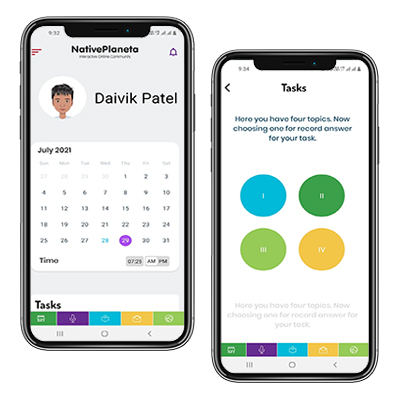
- Alex S.
- 23,Mar 2024
- Mobile
Companies create mobile applications as inexpensively as possible to stay competitive in the digital era. The goal is to maximize the available resources while ensuring the app contains helpful functionalities. Given the increasing prevalence of mobile devices, a successful business must have a high-calibre application. Professional advice becomes crucial for those who want to develop inexpensive mobile applications. Let's look at some strategies for Mobile App Development where getting quality and conserving money meet.
Comprehending the Mobile App Development Process
Entering the realm of Mobile App Development is like setting out on a thrilling adventure with many turns and turns. Your decisions may affect the amount of money you spend at every stage, from the beginning to the big day of launch and beyond. We must delve deeply into the several facets that can make our growth trip economical and practical if we are to sail this expedition effectively. Let's explore the methods for creating an excellent app that doesn't break the bank and guarantees that it is reasonably priced and of the highest calibre.
Different Types of Mobile App Development
There are three basic categories of mobile applications:
- Progressive Web Apps (PWAs)
It redefines the boundaries between web pages and traditional apps. Think of them as the rising stars of the mobile industry. Despite being developed with web technologies, they provide push notifications and offline access, much like native applications. Like your most comfy jeans, they're practical without being clumsy.
- Hybrid applications
Blending web technologies like HTML, CSS, and JavaScript with native components, hybrid applications are the chameleons of the app landscape. It enables products to be developed more quickly and cheaply by allowing them to operate on several platforms with a single codebase. They seem familiar even on other platforms, much like adaptable travel clothes.
- Native applications
Developed especially for one platform (iOS or Android) and utilizing the programming languages particular to that platform, native applications are the original mobile technology superstars. Thanks to this customized approach, they benefit from outstanding speed, a smooth user experience, and seamless interaction with device function. Like tailored suits, they provide excellent utility and a flawless fit.
Cost of Developing a Mobile App
Spending on Mobile App Development has increased significantly due to the growing number of mobile phone users; by 2024, it is expected to reach around $171 billion worldwide. It emphasizes how crucial it is for companies of all sizes to have mobile applications to communicate directly with customers.
The number of features and pages, the underlying infrastructure, the chosen business model, the type of app, the development platforms (Android, iOS, or Windows), the number of features and interfaces, the underlying infrastructure, the hybrid or native design, and any third-party integrations needed all affect how much it costs to develop a mobile app.
Factors Affecting the Price of Developing Mobile Apps
Mobile App Development has several levels that directly affect costs when we dissect it. Important factors that need to be taken into account in light of your financial constraints are:
- The platform (iOS, Android, or cross-platform).
- The intricacy of the functionality.
- The advanced nature of the user interface.
Also, there may be significant financial disparities when choosing between native and hybrid apps.
Cost Breakdown for Developing Mobile Apps in 2024
- Planning and Requirement Gathering: Planning is essential when creating mobile apps. The project manager gets the client's comprehensive requirements to plan the project's progress. App prototyping requires detailed initial requirements. Budgets for requirements collecting, planning, and research typically range from $1000 to $10,000.
- Design Phase Budget: Next, the app's layout is designed by graphic designers. The main goal is to create a visually appealing, user-friendly, and stylish design that complements the type of software. Graphics and photos of high quality are taken into account. Usually, this phase costs between $1000 to $20,000.
- App Development Costs: App development is the most critical and time-consuming stage. To ensure the app satisfies user expectations and works well, much coding and testing is required. Mobile App Developmentcan be carried out in-house or by hiring outside professionals. It's the most costly phase since the team size fluctuates based on the features and size of the app.
Mobile App Development Services by Freelance Developers: $1000 to $10,000.
Mobile App Development Services by a small development team: between $10,000 and $100,000.
Development companies of a medium size: $50,000 to $200,000. Big businesses providing Mobile Application Development Services: $100,000 to $500,000.
Some Effective Strategies to Lower App Development Expenses
Discovering creative solutions to reduce app development expenses without compromising quality is critical as more firms embrace digital transformation. This complex approach uses various techniques, such as open-source tools, cross-platform development efficiency, and MVP tactics. The following are essential approaches designed to reduce costs while improving the functionality of the app:
- Setting feature priorities and creating a minimum viable product (MVP)
An intelligent way to develop mobile applications that are both affordable and effective is to start with a Minimum Viable Product. Developers may quickly release essential components to the market while learning from and iterating based on actual customer input by employing MVP methodologies. This method speeds development and is a barometer for the program's sustainability, possibly saving expensive expenditures on features consumers don't use.
- Cross-Platform Creation: Cutting Expenses
With cross-platform development, you can use one codebase to support several systems, which saves money. Without paying the high price of native development for each platform, businesses can reach a wider audience across web, iOS, and Android platforms with tools like Flutter and React Native.
- Agile Development Approaches: Reducing Expenses
By implementing Agile development concepts, teams may operate in concentrated sprints that promote adaptability and quick response to market demands. This iterative strategy minimizes short-term and long-term costs and directs resources toward high-impact improvements that propel app growth.
- Cost Comparison of In-House vs. Outsourced Development
Cost reductions from outsourcing development are frequently observed when compared to internal efforts. Reducing operational and labour expenses associated with keeping a full-scale, in-house development group is accomplished by having access to a worldwide talent pool and seasoned developers' experience.
- Using Open Source Tools and Frameworks
Using open-source frameworks and tools ensures modernity and robustness while minimizing costs. Businesses may now invest in areas like advertising and user experience enhancements without worrying about budgetary limits thanks to these free tools backed by communities of innovators.
Long-Term Plans to Maintain Low Development Expenses
To stay in the market for a long time and remain competitive, firms must develop long-term plans that lower initial costs and recurring expenditures after launch. These economical steps guarantee that a mobile application may develop steadily without putting undue strain on the budget in the long run. To meet these financial goals and maintain the integrity and functionality of the Mobile Application Development Services, strategies like intelligent scaling and continuous integration are essential.
- Deployment and Continuous Integration: Reducing Post-Launch Expenses
Practices for ongoing integration and deployment are crucial for resource conservation after the app launch. Mobile apps may minimize the need for significant debugging later, saving post-launch expenses and guaranteeing a seamless user experience. This can be achieved by constantly incorporating code upgrades and quick testing. This strategy emphasizes the value of prevention over treatment and enables a more flexible reaction to market developments and customer input.
- Frequent App Updates: Handling Financial Effects
An updated mobile app often stays efficient and meets user expectations and technical improvements. However, it's crucial to evaluate the expenses related to these changes. Preparing for periodic and incremental upgrades may be more economical than sudden and significant changes. This will result in a predictable and controllable cost that companies may include in their long-term financial strategies.
- Managing App Scaling: Steer clear of Needless Expenses
As demand rises, scaling mobile apps makes sense, but growing carefully is crucial. To prevent unneeded and premature expansion, resource and product escalation should align with user demand, analysis of data, and feedback. Careful scaling aids in avoiding significant extra expenses that can affect revenue and customer happiness. By scaling up gradually, you can be confident that every step is essential and brings tangible benefits to the firm and its customers.
- Underestimating the cost of support and maintenance
Although low-cost app creation may seem alluring, ignoring maintenance and support costs may be costly. Ignoring these details can make an app that looks like it would fit into any budget become quite expensive in the long run due to unanticipated problems and the requirement for frequent upgrades.
Preventing Common Pitfalls During Low-Cost Mobile App Development
Achieving success in low-cost Mobile App Development takes more than simply reducing costs; it also requires carefully balancing price and quality while avoiding typical traps. Businesses may mitigate the risks associated with cost-cutting strategies and assure alignment with user expectations and technological sustainability by identifying and resolving these difficulties and making well-informed decisions.
- Underestimating the cost of support and maintenance
Although low-cost Mobile App Development may seem alluring, ignoring maintenance and support costs may be costly. Ignoring these details can make an app that looks like it would fit into any budget become quite expensive in the long run due to unanticipated problems and the requirement for frequent upgrades.
- Disregarding User Input
User feedback is essential to maintain a user-centric experience and shape the app's growth. Ignoring this feedback might cost you money in remedial updates and, worse, cause user annoyance and attrition, endangering the app's commercial viability and the company's reputation.
- Reducing Expenses at the Price of Quality
Cutting expenses is essential, but doing so at the expense of app quality may have dire repercussions. The app's performance depends on several variables: dependability, security, and user experience. Giving up on these features to save costs might lead to bad feedback, a decline in customer loyalty, and a squandered investment.
Case Studies: Successful Narratives of Inexpensive Mobile Application Creation
Achieving success in the mobile app development space on a shoestring budget is frequently seen as an uncommon feat. Let's examine the paths taken by a few businesses to create affordable applications without sacrificing quality.
- Examining Profitable Low-Cost Applications and Their Approaches
Tryko Technologies, which contracted Acquaint Softtech to develop its app, is one noteworthy success story. They saved almost $300,000 by making this move, strengthening their standing in the market. Tryko Technologies has shown that low-budget applications can still be creative and valuable by utilizing global talent, highlighting the value of a frugal strategy.
- Lessons from Low-Cost Development Project Failures
However, only some attempts to create an app at a minimal cost are successful. Too many entrepreneurs have discovered the hard way what happens when they take too many shortcuts. These cautionary tales emphasize how crucial it is to balance the app's quality, usefulness, and cost.
By examining these failures, newcomers may avoid the traps associated with concentrating on financial limitations and instead put user engagement and app resilience as top priorities to secure long-term success.
Final Note
In conclusion, achieving the ideal balance in Mobile App Development is like balancing a tightrope when making high-quality yet reasonably-priced mobile apps. Entrepreneurs are always searching for methods to accomplish this equilibrium. We've covered a variety of approaches in this post, from the outset to the conclusion, for creating excellent and reasonably priced applications.
Businesses may produce excellent applications at a reasonable cost by employing cross-platform development, agile methodologies, and a focus on critical features. Case studies have provided essential insights into striking this equilibrium by showcasing profitable and unsuccessful attempts.
Creating excellent applications at a reasonable price involves careful thought and wise decisions. Businesses may thrive in the cutthroat world of mobile applications by applying the appropriate methods and drawing lessons from past mistakes.
Read More About: How To Choose The Best Mobile App Development Company?Frequently Asked Questions (FAQ's)
What are some low-cost methods for developing mobile applications?
Careful pre-development planning, beginning with a minimal viable product (MVP) and concentrating on critical features, are examples of cost-effective solutions. You may also optimize your app budget by adopting cross-platform development tools, adhering to agile processes, and outsourcing to less expensive locations.
What are the main variables that affect the price of developing a mobile app?
The intricacy of the application, the platform (iOS, Android, or cross-platform), particular design specifications, developer fees, and continuous maintenance and update costs are important considerations.
How may expenses be reduced by preparing before developing a mobile app?
Pre-development planning aids in determining and honing the target market, feature set, app concept, and marketing approach. It guarantees that development aligns with company objectives and lowers the possibility of later, expensive changes.
How can I pick the best affordable mobile app development firm?
Seek out a business with a track record of success, honest pricing, and a well-designed portfolio. Since communication is essential, make sure they can combine pricing, quality, and technical expertise while adhering to best practices in this area.
How do low-cost development choices strike a balance between cost and quality?
Assess developers according to their experience, methodology, and input from clients. Make sure they can produce a high-quality product within your budget and that they are aware of your company's demands.
How might determining my target market lower the cost of developing an app?
Early target audience identification enables you to customize the functionality and appearance of your app to suit their needs. By doing this, extra features that may raise expenses without offering any value are avoided.
Note:
iGex Solutions offers the best custom mobile app development services in the USA and Europe. iGex Solutions is the Best Mobile Application Development Agency, WordPress Development, and SEO Service Provider Company, and we are the Best in Website Design Services. If you want to hire our services, then contact us now!
Web Portfolio
Mobile Portfolio
Categories
What good is an idea if it remains an idea? Let's put efforts together to give it a look of Website or Mobile Application.
Let’s Start a discussion









